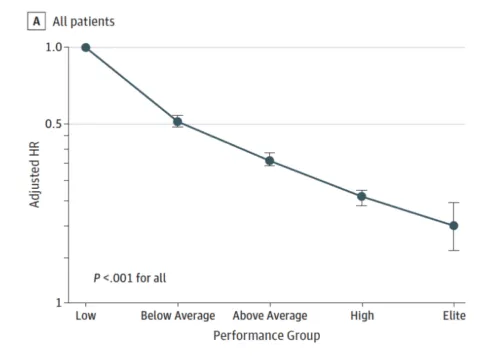In Outlive, Peter Attia introduces a simple but effective framework for thinking about longevity: avoiding the “four horsemen” of chronic disease. 80% of deaths in people over 50 who don’t smoke are caused by one of these:
- Heart disease
- Cancer
- Neurogenerative disease (such as Alzheimer’s)
- Metabolic health (including diabetes, fatty liver disease)

Each of the horsement diiffers in the quality of biomarkers and interventions available, with heart disease having the best “arsenal” and neurogenerative disease being the least well-understood.
This post summarizes the most important biomarkers in Outlive for each of the “four horsemen”, as well as what’s known about what to actually do about each of them.
The four horsemen in Outlive
Let’s go through each of the four horsemen: heart disese, cancer, neurogenerative, and mebolic. We’ll start with heart disease.
Heart disease: good biomarkers, many treatments
Heart disease is easily the area with the most robust set of biomarkers, as well as a strong set of medications, dietary interventions, and research on exercise.
The top biomarkers for heart disease are: ApoB (more accurate than LDL cholesterol), Lp(a) (strongest hereditary factor for heart disease), blood pressure, HbA1c (metabolic heatlh), and eGFR (kidney function).
In addition, VO2Max, resting heart rate, and heart rate recovery measure the strength of the heart muscle (and are improved with exercise). Every 1 mL/kg/min increase in VO2 max reduces risk of death by 9 percent.
 Improving VO2Max reduces your risk of death. Source: JAMA Open
Improving VO2Max reduces your risk of death. Source: JAMA Open
When it comes to reducing your heart disease risk, we know an awful lot about nutritional biochemistry for heart disease.
Nutrition plays a vital role: a high-fiber diet has been shown to reduce both all-cause and cardiovascular mortality (more), while limiting saturated fat helps lower LDL cholesterol. Increasing potassium intake and reducing sodium are linked to lower blood pressure and improved heart outcomes.
Medications for heart disease are numerous and powerful. Statins are the workhorse, ezetimibe is another oral medication that can be used alone or alongside statins to further decrease cholesterol levels, and PCSK9 inhibitors can further reduce cholesterol by 50%. On the horizon, Lp(a), drugs like lepodisiran are showin incredible results (reducing Lp(a) by more than 90%) and will likely be approved in the next few years.
Cancer: some screening, emerging tools.
The current US Preventive Service Taskforce guidelines recommend screening for only four types of cancer: colon, breast, cervical, and lung cancer. These represent about a third of all cancers. Colon cancer can be screened with a colonoscopy or with simple at-home tests (which require a colonoscopy if positive). Breast cancer is screened with mammography. Cervical cancer can be screened both in the office and with at-home test kits.
Sometimes PSA is used to screen for prostate cancer. This has a “C” rating from the USPSTF as of 2018, replacing an earlier “D” rating in 2012.
Some new techniques are in development. Liquid biopsies are blood tests that screen for many types of cancer simultaneously, by detecting cancerous mutations in cell-free DNA. Grail’s Galleri is available as a laboratory-developed test (LDT), with some published clinical research but no FDA approval or insurance coverage. Grail plans to submit an FDA approval application in 2026. After FDA approval, insurance coverage for the Galleri evitible. The other potential technique for cancer screening is MRI. While several companies are offering MRIs for $500-$4,000, none have published clinical research showing how accurate their systems are at detecting cancer so far (Prenuvo launched a study last year).
Tools to fight cancer are advancing rapidly, including surgery, interventional radiology, and chemotherapy. This video interview of Peter Attia and surgeon Edward Chang on brain cancer gives you a sense of how sophisticated the treatmetns are getting:
Neurogenerative disease: least well understood, but what’s good for the heart is good for the brain.
Neurogenerative disease, at first glance, is the hardest of the four horsemen. There are few dedicated biomarkers and no drugs that cure Alzheimer’s (although Donanemab and Lecanemab, approved in 2024 and 2025, do slow progression).
So what are we to do about neurogenerative disease? The good news is that what’s good for the heart is often good for the brain. For example, some studies show cholesterol at 50 predicts neurological health at 70.
So doing the things listed above in heart disease—measuring your ApoB, Lp(a), inflammation (hs-CRP)—gives you a leg up on brain health.
Metabolic health: good biomarkers and treatments
The workhorse biomarker for metabolic health is HbA1c. HbA1c is, roughly, a “3 month average” of your blood sugar.
An HbA1c below 5.7% is normal, 5.7% to 6.4% indicates prediabetes, and 6.5% or higher indicates diabetes. Aside from HbA1C, inflammation (hs-CRP) and the ratio of triglycerides to HDL provide additional information.
You can lower HbA1c for by eating food with lower glyceimic indexes, losing weight, or using medications like metformin.
You can beat the four horsemen in Peter Attia’s Outlive
As you can see, each of the four horsemen have valid biomarkers and interventions. You’ve got this!
Get your free 30-day heart health guide
Evidence-based steps to optimize your heart health.
